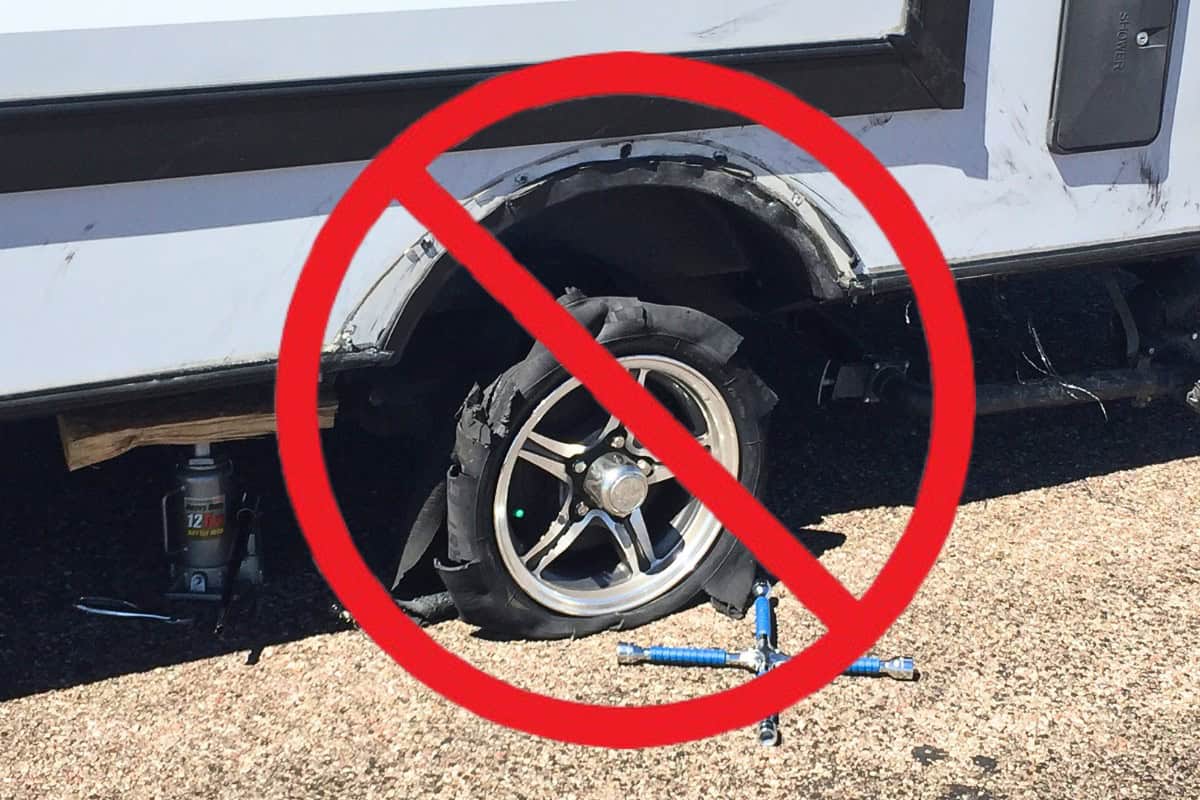When cruising down the highway in your RV, the last thing you want is a tire blowout!
Not only is it dangerous, but RV tire replacement isn’t cheap, costing $200 to $300 per tire. The good news, however, is that RV tire maintenance can extend the life of your tires by as much as 25%, saving you thousands and keeping you safe on the road.
So, let’s check out five simple but effective RV tire maintenance/care tips to help you get the most out of your RV tires.
Understanding Your RV Tires
Before jumping into RV tire maintenance, it’s important to understand a little about tires, especially how they relate to RVs and campers. (This is why it made our list of the 10 most important things RV beginners need to know.)
RVs typically use one of three tire types:
- ST (Special Trailer) tires are designed specifically for trailers, with stiffer sidewalls to handle sway and heavy loads. They’re not meant for steering or driving wheels.
- LT (Light Truck) tires offer better handling and are common on Class B and C motorhomes. They balance load capacity while still maintaining a comfortable ride.
- Commercial truck tires are heavy-duty options found on larger Class A motorhomes, with higher load ratings and more heavy-duty construction.
Understanding your tire’s sidewall markings is also important for proper maintenance. The four-digit code (like “1224”) indicates the manufacture date, the first two digits represent the week, and the last two the year.
It’s also worth noting that tire experts and RV technicians recommend replacing RV tires every 5-7 years, regardless of tread wear, due to rubber deterioration.
Tip 1: Maintain Proper RV Tire Inflation
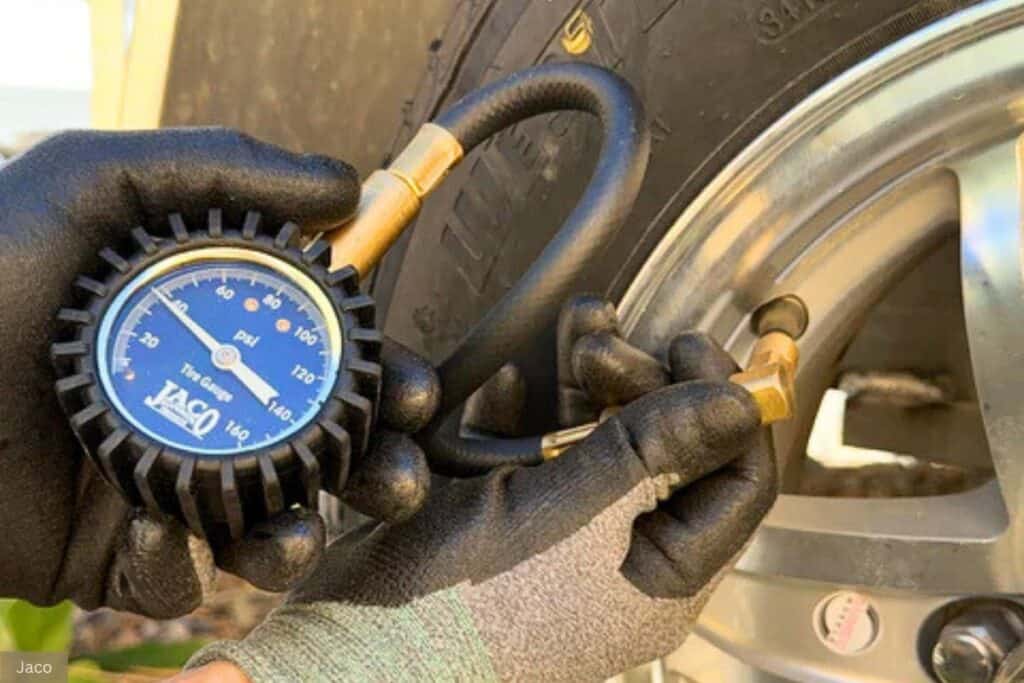
Nothing kills RV tires faster than improper inflation.
Too little pressure causes excessive flexing and heat buildup, while too much creates a harsh ride and uneven wear.
It’s a good idea to check your RV tire pressure before every trip. It takes just a few minutes but can save you countless headaches and problems. Finding your rig’s correct tire pressure is super simple. Check the manufacturer’s sticker (usually inside a cabinet or doorjamb of your RV) or your owner’s manual.
Invest in a quality heavy-duty analog or digital tire pressure gauge like this option on Amazon. The cheap gauges generally don’t hold up and can even be off by several PSI (pounds per square inch).
A Tire Pressure Monitoring System (TPMS) like this highly rated option on Amazon is also a good idea, as it will give real-time pressure readings while driving, alerting you of a potential problem before it becomes an emergency.
Remember that temperature affects pressure significantly (about 1 PSI for every 10°F change). Because of this you should always check pressure when tires are “cold” (before driving more than a mile), and adjust for seasonality and temperature fluxations.
To see other must-have RV tools, check out our blog post “10 Must-Have Tools that Should be in Every RV Tool Kit“.
Tip 2: Use Quality RV Tire Covers
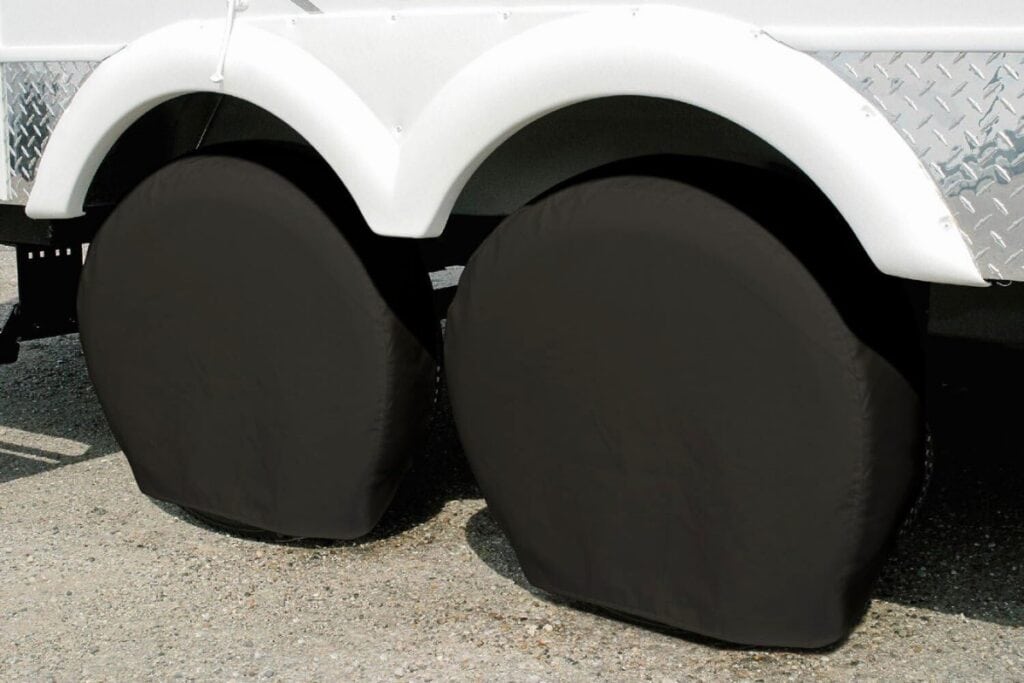
The sun is your RV tire’s worst enemy. UV rays break down rubber compounds, causing sidewall cracking long before the tread wears out. This is especially true during long storage periods. Quality RV tire covers are one of the best ways to prevent this.
When shopping for RV tire covers look for these features:
- UV-resistant material that blocks harmful rays
- Breathable fabric that prevents moisture buildup
- Secure fastenings to prevent wind from blowing them off
- Reflective options for extreme heat climates
While premium covers run $40 to 50 for a set of four, even budget options that cost $25 or less still offer significant protection. Making RV tire covers a no-brainer.
When installing covers, ensure the tires are clean and dry first. Slip the cover over from top to bottom, and secure all fasteners.
Tip 3: Understand & Practice RV Weight Distribution
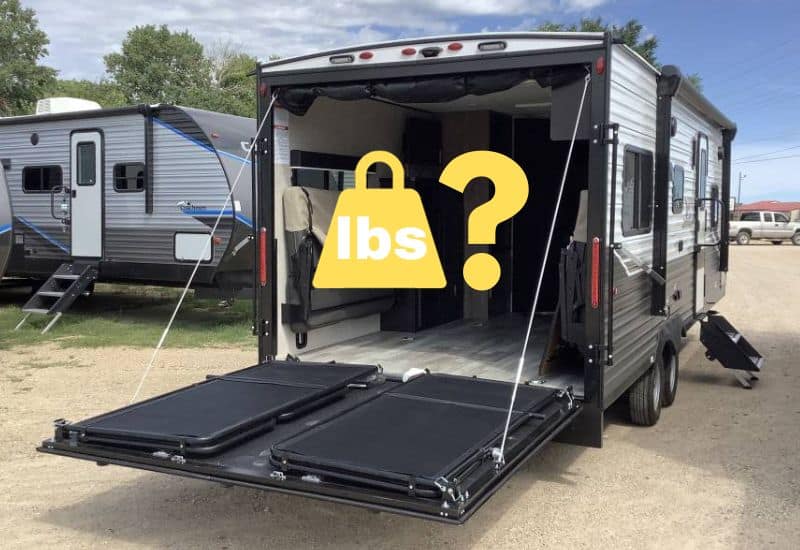
RV tires carry the weight of your entire rig. When you’re overloaded or the weight isn’t properly distributed, certain tires work harder than others, leading to uneven wear and early failure.
RV owners often unknowingly overload their rigs, as they’re unaware of their camper’s weights, including unloaded (dry) weight, cargo carrying capacity (CCC), and gross vehicle weight rating (GVWR).
You can avoid making this common RV mistake by taking these steps:
- Load your camper as you normally would for a camping trip, including all clothing, supplies, and gear.
- Get your RV weighed at a commercial scale (many truck stops offer this service).
- Get the total weight and ideally the weight of each axle individually.
- Look up your camper’s unloaded weight, cargo carrying capacity, and gross vehicle weight rating set by the RV manufacturer. (You can find this information inside your RV’s door well, inside a cabinet, the owner’s manual, or online.)
- Compare results against your RV manufacturer’s GVWR (Gross Vehicle Weight Rating) to ensure you’re under the maximum weight limit and the load is evenly distributed.
If you’re overloaded, it’s time to remove some weight. Think about which items you rarely use and start there. For persistent weight issues, you can also look into suspension upgrades like heavier springs or auxiliary airbags to handle more weight.
Intentional packing makes a difference too. Keep heavy items low and centered over the axles. Distribute weight evenly side-to-side. These simple adjustments will dramatically affect how your tires wear and their lifespan.
Tip 4: Practice Routine Tire Inspections
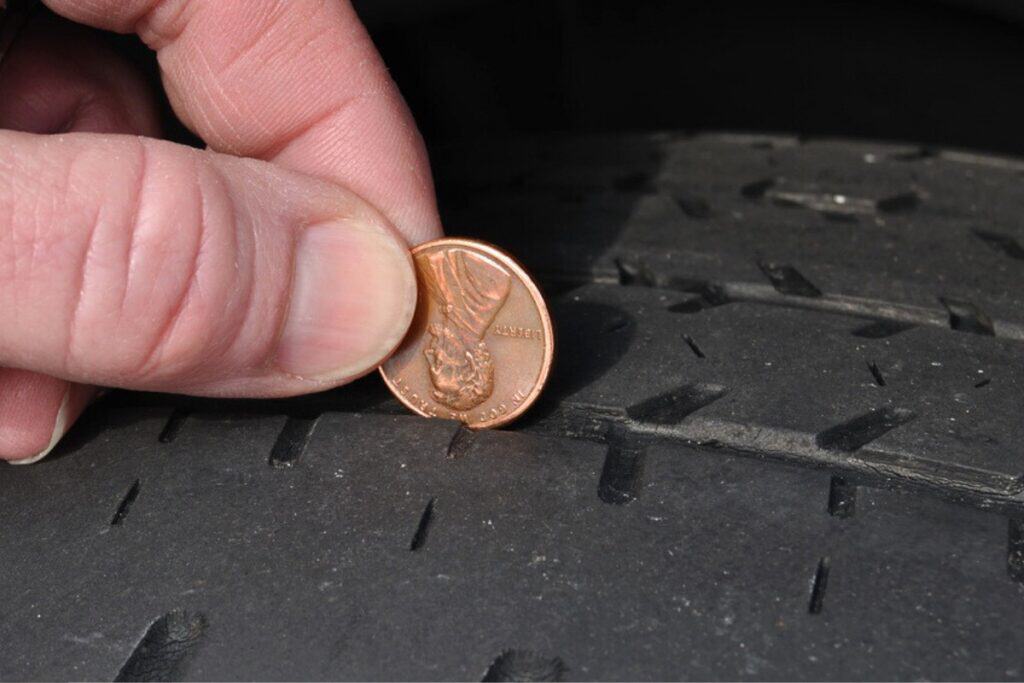
Another great way to extend the life of your RV tires and practice good RV tire maintenance is to develop the habit of walking around your RV before each travel day and inspecting all tires with a critical eye.
When inspecting your RV tires look for:
Sidewall cracks – small weather checking, should be closely monitored; deep cracks mean the tires should be replaced
Bulges or blisters – always a red flag requiring immediate attention
Uneven tread wear – indicates alignment or inflation issues
Foreign objects – nails, screws, glass that might cause slow leaks
Valve stem condition – rubber deteriorates here too
Also, the penny test remains a reliable tread check. Insert a penny with Lincoln’s head downward, if you can see the top of his head, your tread is too worn.
Tip 5: Regular RV Tire Upkeep
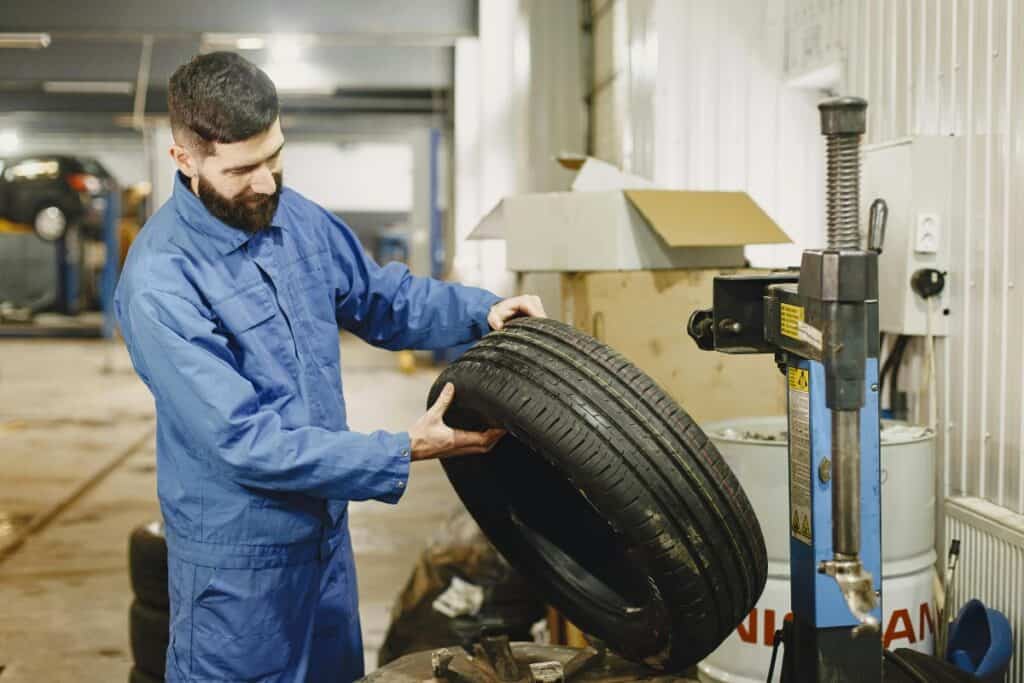
While there’s plenty you can do yourself, some aspects of tire maintenance require professional equipment and expertise.
Balancing ensures your tires rotate without vibration, preventing uneven wear. Do this whenever you feel vibrations or after you’ve replaced the tires.
Alignment checks that all wheels point in the proper direction. Signs you need an alignment include uneven tire wear, the RV pulling to one side, or a steering wheel that’s off-center when driving straight.
For both these services and more, find an RV-friendly service center with heavy-duty equipment, technicians familiar with RVs, large bay doors, and positive reviews from other RVers.
Call ahead to confirm they can accommodate your specific RV. When you find a good shop build a relationship, as good RV service centers are worth their weight in gold.
Finally, it’s important to create a maintenance schedule based on both time and mileage:
- Monthly: Visual inspection, pressure check, cleaning
- 6,000 miles or annually: Professional rotation, balance check
- 12,000 miles or bi-annually: Alignment check
- 5-7 years: Replacement regardless of appearance
For weekend warriors, seasonal checks make more sense than mileage-based ones. Also, always perform thorough inspections before and after storage periods.
RV Tire Maintenance Products Worth Investing In
Beyond covers and pressure gauges, several other products also help to extend tire life, these are some of our favorites:
- Tire protectants with UV inhibitors (avoid petroleum-based products)
- Cleaners specifically formulated for rubber
- Portable air compressor capable of reaching your required PSI
- Torque wrench for proper lug nut tightening
- Tire chocks to prevent rolling during maintenance
Budget-conscious RVers or RV beginners can start with the basics (pressure gauge, covers, cleaner) and add specialty items as finances allow.
Final Thoughts on RV Tire Maintenance
Proper RV tire maintenance isn’t complicated, but it does require consistency.
Proper inflation, quality covers, even weight distribution, regular inspections, and a professional service schedule can dramatically extend the useful life of RV tires.
They can also help with peace of mind when traveling down the road in your camper.
Additional RV Maintenance Resources:
- Leveling Jacks & Class C RVs: What You Need to Know
- Why Do Travel Trailers Only Last 10 Years? (9 Main Reasons)
- What Do You Put Under RV Jacks? 5 Best Options
Recent Posts
Nothing ruins an RV adventure faster than a breakdown with no way to fix it. Because of this, every RVer should have a well-stocked RV tool kit for those unexpected roadside emergencies and campsite...
10 Best Travel Trailer Brands for the Money (Plus 5 To Avoid)
With more new RVers joining the RV lifestyle each year, it's never been more important to find the best travel trailer brands. It's also never been more confusing, as there are hundreds of...

